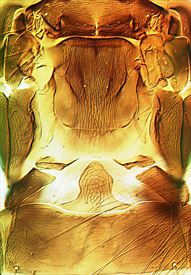Distinguishing features
Both sexes fully winged. Female similar in colour to choritus, but fore tibiae and fore tarsi a little paler, fore wings more extensively shaded. Structure similar to choritus, but head with postocular setae slightly closer together, maxillary stylets retracted to eyes; pronotum entirely sculptured, pronotal anteromarginal setae well developed, also midlateral, epimeral, and posteroangular setae longer and capitate; metanotum with striate sculpture, finer on raised medial area, median setae usually pointed, up to 4 pairs of smaller scattered setae anterior to these; fore wings with 11–17 duplicated cilia, sub-basal setae S3 expanded; foretarsal tooth more acute.
Male similar to female but postocular setae often shorter, sometimes bluntly pointed; pronotal setae shorter, less expanded at apex, anteromarginal setae reduced; fore wing with sub-basal setae S3 shorter, acute; sternite VIII without a pore plate.
Related species
The genus Hoplandrothrips comprises about 120 species worldwide, particularly in tropical areas, but with nine species recorded from Europe, 16 from Australia, and four from New Zealand. H. ingenuus is very similar to H. choritus, but has the metanotal sculpture more striate and the males lack a pore plate on sternite VIII.
Biological data
Fungus feeding on dead branches of Nothofagus menziesii.
Distribution data
Known only from New Zealand (NN, BR).
Family name
PHLAEOTHRIPIDAE, PHLAEOTHRIPINAE
Species name
Hoplandrothrips ingenuus Mound & Walker
Original name and synonyms
Hoplandrothrips ingenuus Mound & Walker, 1986: 57.
References
Mound LA & Walker AK (1986) Tubulifera (Insecta: Thysanoptera). Fauna of New Zealand 10: 1–140.




